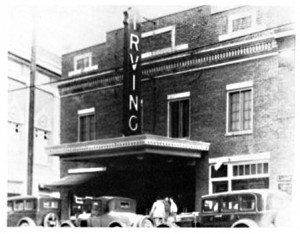Across Indianapolis from the late 1930s through the 1960s, thousands of kids could be found every Saturday afternoon at their neighborhood movie theater enjoying a special “kiddie matinee.” After paying an admission from 10ȼ to 35ȼ, the next stop was the concession stand — a box of popcorn, a cup of soda, and a box of candy (maybe Necco Wafers, or my favorite, Milk Duds). Finding a seat in the auditorium was next; I usually liked a seat mid-way back from the screen, preferably near the aisle so I could easily return to the concession stand to replenish my sugar needs. The guys with dates found their way to the “make-out” seats along the wall or in the back of the theater. Before the lights dimmed and the cacophony of voices stilled, there was the usual bantering and the flipping of popcorn flakes at a favorite girl.
Neighborhood theaters were as much a part of a child’s life as the neighborhood school, and Indianapolis had movie theaters east, west, uptown, and downtown with magical names like Oriental, Dream, Ritz, Pixy, and Zaring Egyptian. Growing up on the Eastside in Irvington, my theaters were the Irving and the Arlington; like most boys, sliding along that great curved wall beyond the concession stand on my way to a seat in the Arlington was a must. Today most are fading memories, but a few, like the Irving, the Emerson, and the Vogue have been repurposed as venues for live entertainment, and efforts continue to raise funds for the restoration of the Rivoli.
By 1908, the first neighborhood moving picture theaters had opened. The New Bijou Theater, 1269 Oliver Ave., was offering moving pictures to residents of the West Indianapolis neighborhood and the Palace Amusement Co., 2540 W. Michigan St., was drawing crowds in the Haughville neighborhood. The following year the Fountain Eagle Theater opened its doors at 1117 Shelby in Fountain Square, and Southsiders soon were enjoying the flickering images on the silver screen at the Oriental, 1105 S. Meridian St.
Irvington was the last Indianapolis neighborhood to get a “photo-play house” because the good people of that community viewed the motion picture “as a menace to youthful morals.” In December 1913 the Idle Hour Amusement Co. opened the Irving, a one-story brick structure at 5507 E. Washington St, showing films that had to be “clean and of an educational nature” — no thrillers. Among the early moving pictures shown at the Irving for a 10ȼ (2016: $2.41) admission was a film adaptation of Shakespeare’s Antony & Cleopatra. The program soon changed, however, and moviegoers were seeing popular Hollywood stars like Mary Pickford in Little Pal.
In addition to offering a new motion picture or two every other day or so to attract moviegoers, neighborhood theaters included a weekly serial action film in the program, too. The Perils of Pauline (Pearl White) and Casey of the Coast Guard (George O’Hara) were among the silent serials that drew early movie audiences back to the theater week after week. Later the golden age of serials kept kids on the edge of their seats each week with an episode of Flash Gordon (Buster Crabbe and Jean Rogers), The Lone Ranger (Lee Powell and Chief Thundercloud), Dick Tracy (Ralph Byrd and Kay Hughes), The Green Hornet (Gordon Jones), or Terry and the Pirates (William Tracy), as well as many others. Another draw to the neighborhood theaters on hot, sultry summer evenings was their air conditioned comfort. In 1930 Roland Bair’s theaters — the Uptown, Ritz, Oriental, Strand, and St. Clair — were among the early neighborhood motion picture houses to proclaim “Cool Inside.” Theaters also offered special promotions, such as a Halloween costume contest, to draw in a crowd. As a nine or ten-year old, my wife won the contest at the Oriental Theater one year dressed as an old woman.
A Saturday afternoon of movies stimulated kids’ imagination for week-long backyard cowboys and Indians play-acting or swashbuckling re-enactments. Thriller and monster horror movies, on the other hand, stayed with us on the walk home in the late afternoon twilight (the pace quickened if passing a stream or pond after watching the Creature from the Black Lagoon) and in our beds after dark (what’s lurking in the shadows?).
All sections of Indianapolis society frequented the neighborhood theaters, even African-Americans in segregated seating, during the golden age of movies. However, there was one group that could not attend movie theaters — Catholic nuns. Prohibited by their orders from going to theaters, nuns were provided an alternative during the 1950s when Eastsider Harold C. Braun, a motion picture projectionist, arranged private showings.
Slowly the dazzling marquees went dark as the neighborhood theaters faded into memory like the mom and pop neighborhood stores and were replaced by national chain multiplex cinemas — General Cinema and United Artists — at the shopping malls. While plush reclining seats with cup holders replaced the more familiar hard cushioned seats, one thing remained a constant: What about those “sticky” floors?
Next –The Passion Pits.



